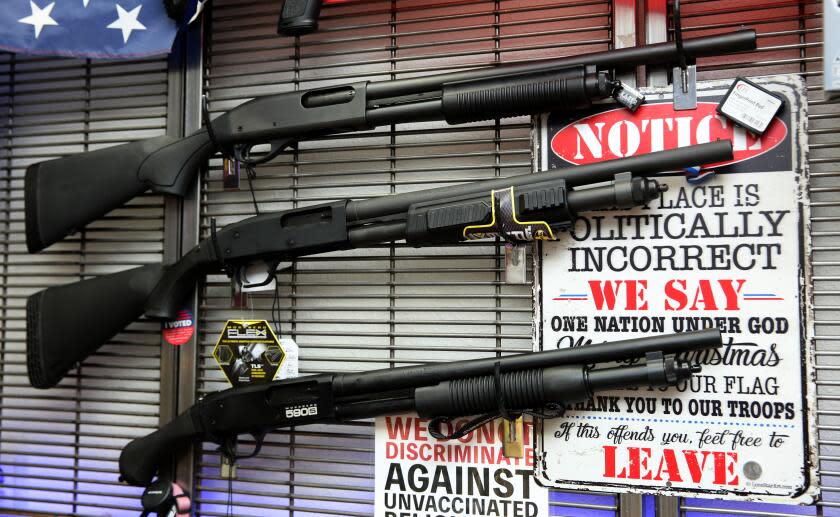Opinion: Will California's new tax on gun sales reduce firearm violence?

For the record:
10:20 a.m. May 21, 2024: An earlier version of this piece stated that U.S. gun sales grew tenfold over the past 20 years. They grew fourfold.
California will be the first U.S. state to charge an excise tax on guns and ammunition, starting in July. The new tax — an 11% levy on each sale — will come on top of federal excise taxes of 10% or 11% for firearms and California’s 6% sales tax.
The National Rifle Assn. has characterized the law that allows this new tax, the Gun Violence Prevention and School Safety Act, as an affront to the Constitution. But the reaction from the gun lobby and firearms manufacturers may hint at something else: the effect that the measure, which is aimed at reducing gun violence, may have on sales.
One way to think about the law’s ramifications is to compare state tax policies on firearms with those on alcohol and tobacco products. It’s not for nothing that these all appear in the name of the Bureau of Alcohol, Tobacco, Firearms and Explosives. The ATF focuses on those products because, while legal, they can cause significant harm to society in the form of drunken driving, for example, or cancer-causing addictions. They also have a common history: All have been associated with criminal organizations seeking to profit from illicit markets.
Read more: Opinion: Here's a new California tax that could prevent gun violence
Alcohol and tobacco products are thus usually subject to state excise taxes. By making a given product more expensive, this type of tax leads people to buy less of it, reducing the harm to society while generating tax revenue that the state can theoretically use to offset those harms that still accrue.
California, for instance, imposes a $2.87 excise tax on each pack of cigarettes. That tax is higher than the national average but much lower than New York’s $5.35 levy. California also imposed a vaping excise tax of 12.5% in 2021.
Of the four ATF product families, firearms have enjoyed the absence of any state excise taxes. Until now.
Anti-gun advocates and policy analysts have long called for the firearm industry to be subject to the same types of taxes as alcohol and tobacco given the harms that firearms cause. The national rate of gun homicides in 2021 was 4.5 per 100,000 people, eight times higher than Canada’s rate and 77 times that of Germany. It translates into 13,000 lives lost every year.
Read more: Opinion: The border crisis factor no one talks about: American guns
Additionally, nearly 25,000 Americans die from firearms suicide each year. Moreover, more people suffer nonfatal firearm injuries than die by guns, according to the Centers for Disease Control and Prevention.
Gun deaths and injuries aren’t just tragic — they’re expensive. One economist estimated the benefit-cost ratio of the U.S. firearms industry at roughly 0.65 in 2009. That means for every 65 cents it generates for the economy, the industry produces $1 of costs. And that calculation didn’t include nonfatal injuries within the U.S., or the cost of firearm harms occurring outside the country with U.S.-sold weapons.
U.S. gun sales have grown fourfold over the past 20 years to about 20 million guns annually, and they’re now deadlier and more expensive than ever. California is making sure they are taxed accordingly.
And what should that tax amount to? There’s an argument to be made that firearms should be taxed at a higher level than alcohol and tobacco, which are consumable products that disappear as soon as they’ve been used — guns stick around. They accumulate and can continue to impose costs long after they’re first sold.
When the new law takes effect in July, California will tax firearms at about the level of alcohol. But the state would have to apply an excise tax of an additional 26% to equal its effective tax on tobacco.
It’s unclear how the new tax will affect gun violence. In theory, it should be highly effective. In 2023, some colleagues and I modeled the U.S. market for firearms and determined that for every 1% increase in price, demand decreases by 2.6%. This means that the market should be very sensitive to tax increases.
Using these figures, another colleague recently estimated that the California excise tax would reduce gun sales by 30% to 44%. If applied across the country, the tax could generate an additional $1.5 billion to $1.9 billion in government revenue.
But a problem may come from surrounding states: It’s already easy to illegally transport guns bought in Nevada, where laws are more lax, to California. But there’s some evidence that suggests our state’s new policy won’t be neutralized by its neighbors.
When the federal assault weapons ban expired in 2004, making it much easier to buy AR- and AK-style rifles across much of the U.S., gun murders in Mexico skyrocketed. Two studies show the exception was the Mexican state of Baja California, right across the border from California, which had kept its state-level assault-weapons ban in place.
Gun seizures in Mexico show that all four U.S. states bordering Mexico rank in the top five state sources of U.S.-sold guns in Mexico. But California contributes 75% less than its population and proximity would suggest it should.
So, California laws seem to already be making a difference in reducing gun violence. The excise tax could accomplish still more. If it does, other states may follow California’s lead and work to reduce firearm violence by hitting gun manufacturers at the spot they value most — their bank accounts.
Topher L. McDougal is a professor of economic development and peacebuilding at the University of San Diego. This article was produced in partnership with the Conversation.
This story originally appeared in Los Angeles Times.

